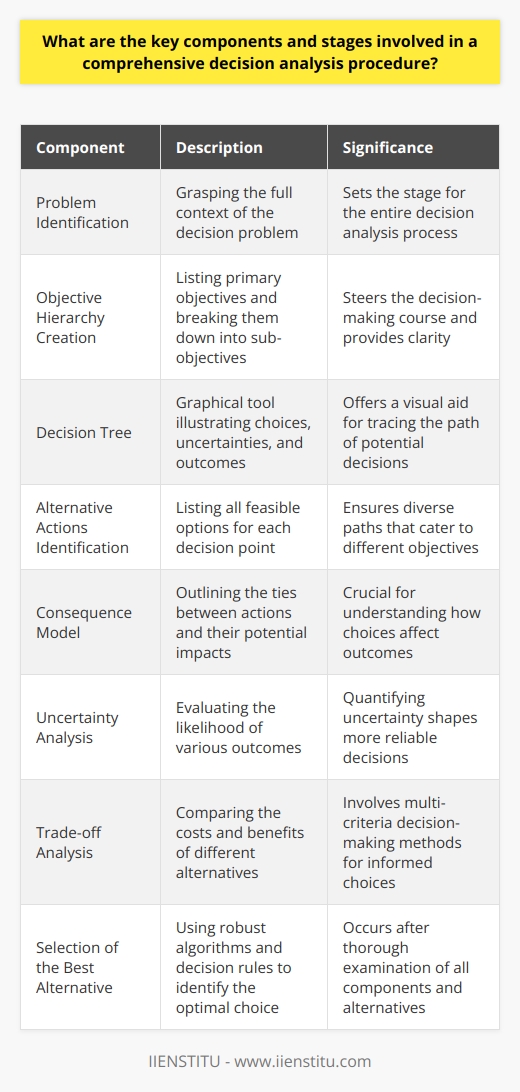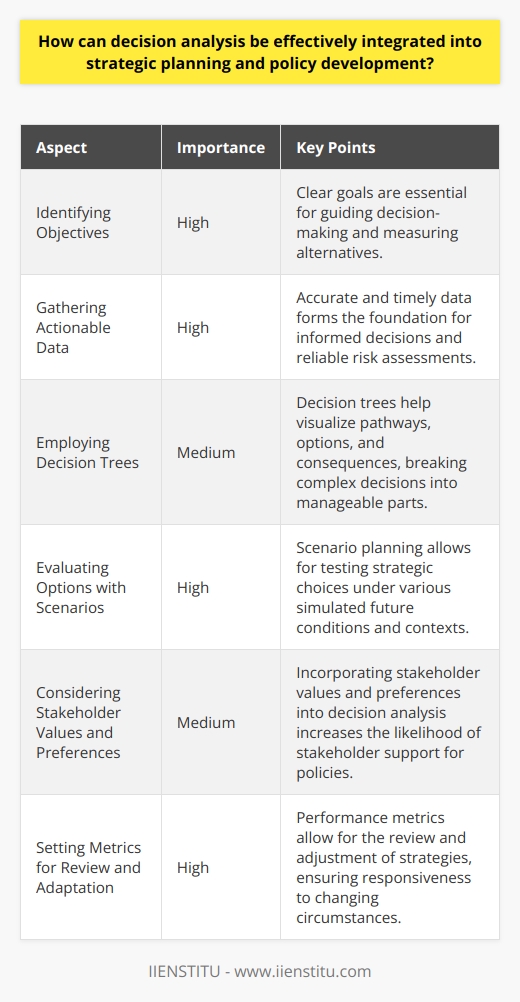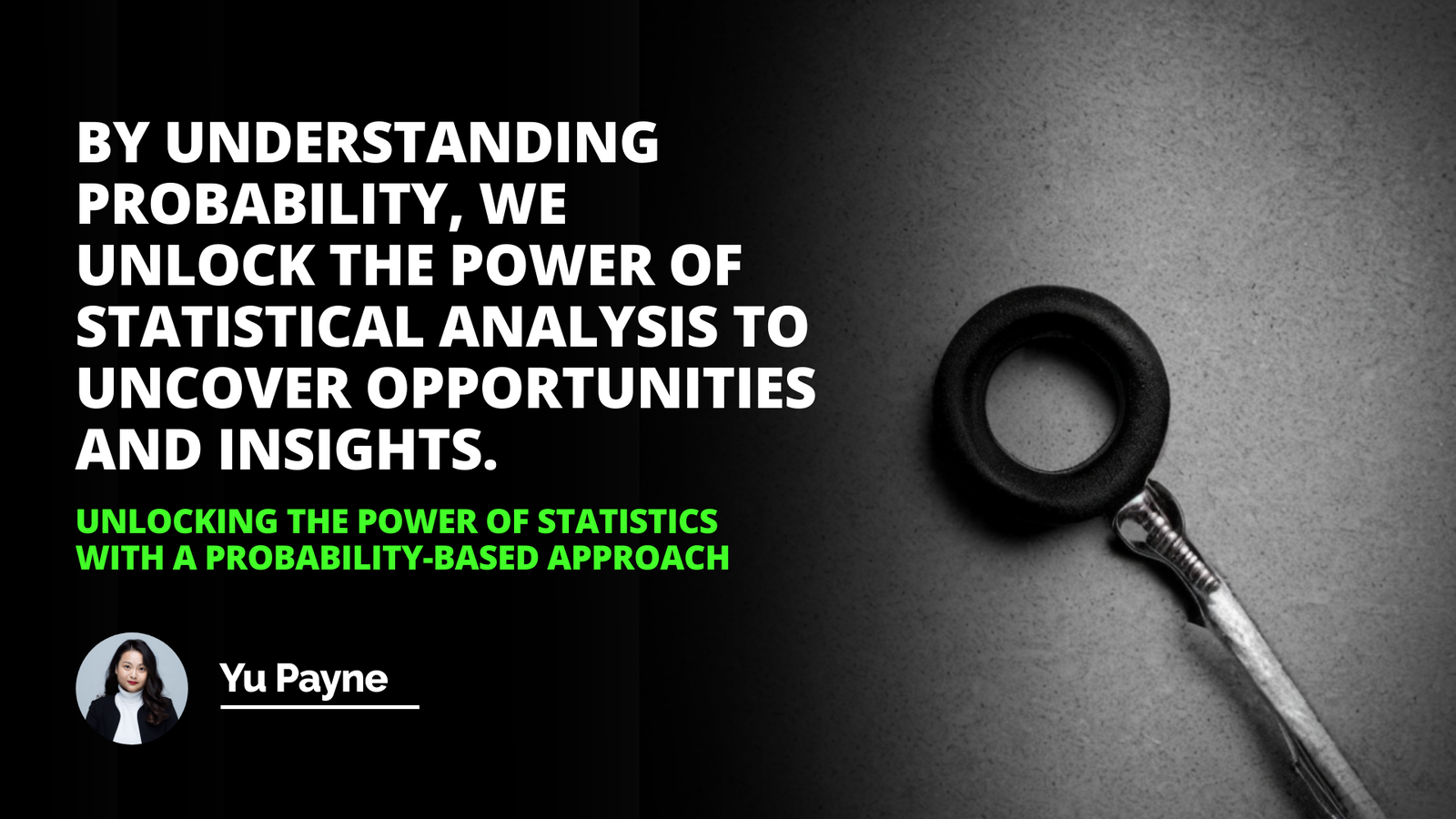
In the ever-evolving landscape of business and personal life, the ability to make clear, effective decisions is a powerful skill. Decision analysis, a toolset rooted in quantitative and qualitative methodologies, empowers individuals and organizations to dissect and understand the intricacies of their choices. This transformation of decision-making from a feared challenge into a structured and manageable process is a testament to the significance of decision analysis across myriad scenarios, whether at the helm of a corporate entity or deliberating over personal milestones.
Fundamentals of Decision Analysis
Steps in Decision Analysis
Taking on decision analysis involves a multi-step process designed to break down decision-making into manageable and logical parts. Initially, one must define the decision problem, laying out the context and boundaries of what's at stake. Following this, developing objectives that align with one's goals is crucial, acting as a compass throughout the subsequent stages. Umpteen options present themselves, necessitating the step to identify alternatives. Each alternative then requires a thorough assessment, contemplating the consequences of each alternative. Quantitative metrics and risk assessments often accompany this evaluation. After assimilating all this information, the final act is to make the decision, which, ideally, springs clearly from the preceding analysis.
The Role of Decision Trees in Decision Analysis
One of the key tools in decision analysis is the decision tree, a graphical representation that maps out the pathways of choices and their potential outcomes, including uncertainties and resource costs. This tool aids in visualizing the consequences of each decision branch and tracing the journey back from possible outcomes to the original decision topic. The decision tree is particularly useful in complex decision-making scenarios, as it allows for both probabilistic calculations and subjective judgments, accommodating utility and preference, essential human elements in decision-making.
Example of Using Decision Analysis in Making Business or Personal Decision
To contextualize decision analysis, consider a business deciding whether to launch a new product. The company would construct a decision tree outlining various market responses, estimate probabilities for each, and calculate potential financial outcomes. By comparing these scenarios, the business gleans the best course of action, underpinned by a granular and transparent rationale—a testament to the profound utility of decision analysis. Similarly, in personal life, decision analysis can be applied when considering major life changes such as buying a house, changing careers, or planning for retirement.
Types of Decision Analysis
Descriptive Decision Analysis
Descriptive decision analysis explains why individuals make decisions, recognizing that real-world choices often deviate from rational models. It studies past decisions within context, aiding the understanding of human behavior and judgment under uncertainty. Though it veers toward the psychological aspects of decision-making, it plays a vital role in tailoring decision-analysis frameworks to accommodate behavioral idiosyncrasies.
Normative Decision Analysis
Normative decision analysis outlines how decisions should be made to maximize outcome utility according to a predefined system of values or preferences. Given specific criteria and objective functions, this framework can intimate the 'ideal' choice. It does not necessarily reflect actual decision-making processes but is a benchmark against which real-world decisions can be evaluated.
Prescriptive Decision Analysis
Prescriptive decision analysis recommends how decisions should be made in real-life scenarios, bridging the gap between the actual and the ideal. It typically incorporates findings from descriptive analyses to account for behavioral factors and utilizes normative models to guide better decision-making. For instance, when faced with financial choices, individuals might be inclined to act out of heuristic biases. Prescriptive decision analysis could guide them toward more favorable outcomes by emphasizing rational investment strategies informed by normative principles.
Tools Used in Decision Analysis
Explanation of Various Decision Analysis Tools
Numerous tools facilitate the decision analysis process, each catering to specific contexts and information sets. The decision matrix aids in evaluating and prioritizing a set of options against weighted criteria. Decision trees, as previously mentioned, elucidate the paths of complex decisions. Multicriteria decision-making (MCDM) emerges as a suitable method for handling multifaceted and conflicting criteria. In situations with inherent uncertainty, the Monte Carlo simulation projects numerous potential outcomes based on probability distributions and random sampling, providing a sense of the risk landscape.
Choosing the Right Tool for Specific Decision-Making Processes
Selecting an appropriate decision analysis tool hinges on the nature of the decision problem. The volume and type of data, the clarity of objectives, uncertainty, and the need for collaboration among stakeholders all influence this choice. A crucial aspect is aligning the tool's capabilities with the end goal—clarity, consensus, or computation of risk-optimized strategies.
Example of How to Use Each Tool in Analyzing Decisions
Imagine a project manager grappling with resource allocation. A decision matrix could rank projects by importance and resource demand. Meanwhile, a decision tree could trace the implications of economic fluctuations, regulatory changes, and consumer trends in strategizing entries into new markets. For a policy maker balancing economic growth with environmental impact, MCDM could navigate the trade-offs. Meanwhile, an investment firm considering asset portfolios might employ Monte Carlo simulations to perceive risk across market volatilities.
Factors Influencing the Effectiveness of Decision Analysis
Quality and Availability of Data
The quality and availability of data are paramount for decision analysis to be influential and yield accurate forecasts. The adage "Garbage in, garbage out" holds true here. Inconsistent or incomplete data can lead to skewed analyses and suboptimal decisions.
Understanding of the Decision Situation
All the tools and data are only helpful when one profoundly understands the decision situation. A well-articulated problem frame, knowledge of stakeholder influence, and social or organizational context set the stage for practical analysis.
Knowledge of Decision Analysis Techniques
The practitioner's knowledge of decision analysis techniques heavily sway the process's outcomes. Expertise ensures the correct application of tools and encompasses an experienced interpretation of the analysis's results. Furthermore, the ability to communicate decisions effectively cannot be overstated. A transparent decision rationale fosters trust and facilitates buy-in from stakeholders.
Benefits and Limitations of Decision Analysis
Discussing the Benefits of Using Decision Analysis
Decision analysis brings a sense of structure and clarity to the decision-making process. It helps in handling complex choices by illuminating key elements and trade-offs, thereby reducing the influence of cognitive biases. This methodical approach encourages accountability and justification of choices, boosting stakeholder confidence and making the decision-making process more organized and controlled.
Addressing the Limitations and potential Challenges in using Decision Analysis
However, it's important to be aware of the potential for over-sophistication and analysis paralysis in decision analysis. Users' bounded rationality can constrain decision analysis, and the data's integrity can be a challenge. Additionally, some critique the cold logic of quantitative methods that might underplay the qualitative aspects of human-centered decisions. Being cautious and aware of these potential pitfalls is crucial in using decision analysis effectively.
In conclusion, decision analysis is not merely a set of tools or techniques but a comprehensive approach to dissecting choices and formulating paths toward optimal outcomes. It marries structured methodologies with an understanding of human behavior and organizational dynamics. Individuals and teams must commit to continuous learning, openness to emerging data, and flexibility to adapt decision frameworks as situations evolve to benefit from decision analysis in personal and professional spheres. Therein lies the crux of harnessing the power of decision analysis—grasping the fluidity of decisions while navigating them with steadfast rationality and insight.
Frequently Asked Questions
What are the key components and stages involved in a comprehensive decision analysis procedure?
Understanding Decision Analysis
Decision analysis represents a systematic, quantitative, and visual approach to addressing, analyzing, and solving complex decision problems. It marries a structured thought process with analytical rigor. Professionals harness this approach to make informed choices under conditions of uncertainty.
Key Components of Decision Analysis
Problem Identification sits at the core of decision analysis. Analysts do not work in a vacuum. They must grasp the problem's full context. This clarity sets the stage for the entire process.
Next comes Objective Hierarchy Creation. Analysts list primary objectives. Each objective then breaks down into sub-objectives. These elements steer the decision-making course.
Then, analysts build a Decision Tree. This graphical tool illustrates choices, uncertainties, and outcomes. It offers a visual aid for tracing the path of potential decisions.
Alternative Actions Identification follows. Each choice demands careful consideration. Analysts list all feasible options in this component. Diverse paths cater to different objectives.
Understanding the Consequence Model is crucial. How do choices affect outcomes? This model outlines the ties between actions and their potential impacts.
Analysts should then undertake Uncertainty Analysis. This evaluates the likelihood of various outcomes. Quantifying uncertainty shapes more reliable decisions.
Trade-off Analysis plays an important part. Decision-makers compare the costs and benefits. This often involves multi-criteria decision-making methods.
Lastly, the Selection of the Best Alternative occurs after thorough examination. Experts use robust algorithms and decision rules to identify the optimal choice.
Stages in Decision Analysis Procedure
At the outset, lies Problem Structuring. Define the decision context. Map out objectives and challenges. Sound structure houses the entire decision-analysis process.
Information Gathering then takes precedence. Collect data relevant to the problem. This data guides the analysis.
Professionals then branch into Model Formulation. Develop a model to simulate real-world scenarios. Models illuminate complex decision landscapes.
Model Analysis scrutinizes the formulated model. Experts test various scenarios. Robust model analysis yields deeper insights.
After model analysis, comes Option Evaluation. Weigh each alternative against established criteria. Enlightened evaluation precedes final choices.
Sensitivity Analysis helps understand the impact of uncertainty. Alter inputs and observe outcomes. Resilient decisions withstand uncertainty perturbations.
Finally, Recommendation and Implementation of Action conclude the process. Present the best alternative. Implement the chosen action with confidence.
Inference
Decision analysis offers a comprehensive map through the maze of complex decisions. Each component and stage carries its own weight. The delicate interplay of these parts leads to insightful, robust decisions. Decision-makers equipped with this method stand better equipped to navigate the choppy waters of uncertainty.

How can decision analysis be effectively integrated into strategic planning and policy development?
Integrating Decision Analysis in Strategic Planning
Strategic planning provides the blueprint for organizations' futures. It maps out the direction, goals, and the methods to achieve them. Decision analysis is a vital tool in this process. It helps in understanding the complexities of decisions. It weighs options against probabilities and outcomes.
Identifying Objectives Clearly
For success, organizations must identify their objectives clearly. Goals guide decision-making. They provide a yardstick for measuring alternatives. Without clear goals, comparing options becomes difficult.
Gathering Actionable Data
Data drives decision analysis. Managers need accurate, timely information. This data forms the foundation for informed decisions. Without good data, risk assessments are less reliable.
Analyzing Risk and Uncertainty
Risk and uncertainty are central to strategic planning. Decision analysis helps to quantify these elements. It employs statistical tools to assess potential outcomes. Strategies benefit from this careful, quantified approach.
Employing Decision Trees
Decision trees are useful in mapping choices. They help decision-makers visualize pathways. Options and consequences become clearer with decision trees. This tool breaks complex decisions into simpler, manageable parts.
Evaluating Options with Scenarios
Scenario planning allows for testing strategic choices. It simulates future conditions and contexts. Decision-makers can see how strategies might unfold under various scenarios. This deepens understanding of the potential effects of decisions.
Using Multi-Criteria Decision Analysis
Sometimes decisions involve competing criteria. Multi-Criteria Decision Analysis (MCDA) assists in these instances. It scores options against a range of factors. This provides a structured way to balance trade-offs.
Running Sensitivity Analyses
Strategies must withstand changes in conditions. Sensitivity analyses predict the robustness of decisions. They show how outcomes might change with different inputs. This fortifies planning against unforeseen events.
Considering Stakeholder Values and Preferences
Strategies affect and are affected by stakeholders. Decision analysis recognizes the importance of stakeholders' values. It ensures their preferences factor into planning. This increases the likelihood of stakeholder support for policies.
Setting Metrics for Review and Adaptation
Plans need monitoring and adaptation for relevance. Decision analysis sets performance metrics. These allow for the review and adjustment of strategies. They ensure responsiveness to changing circumstances.
Applying Continuous Learning
Organizations must evolve through learning. Decision analysis supports a learning culture. It involves reviewing decisions and outcomes. This leads to better decision-making processes over time.
Conclusion
Effectively integrating decision analysis with strategic planning improves outcomes. It aligns goals, actions, and performance measurement. This integration results in resilient, flexible, and supported strategies. It aids organizations in navigating the uncertain future with confidence.

What are the common biases and cognitive errors that can affect decision analysis and how can they be mitigated?
Cognitive Biases in Decision Analysis
Decision analysis often falls prey to cognitive biases. These are systematic patterns of deviation from norm or rationality in judgment. They lead to perceptual distortion, inaccurate judgment, or illogical interpretation.
Confirmation Bias
It involves favoring information that confirms pre-existing beliefs. People tend to dismiss evidence that contradicts what they already believe. This skews decision-making.
Mitigate by:
- Seeking disconfirming evidence.
- Adopting a devil’s advocate position.
- Holding group members accountable for unbiased evaluation.
Anchoring Bias
This bias occurs when individuals rely too heavily on an initial piece of information. The first number or option sets a reference point from which adjustments seem incremental.
Mitigate by:
- Being aware of initial values' influence.
- Considering a range of alternatives.
- Thinking about the decision in different contexts.
Availability Heuristic
People often judge the probability of events by how easily examples come to mind. This can be misleading if recent or vivid experiences are not representative.
Mitigate by:
- Looking for actual statistical evidence.
- Using checklists to ensure comprehensive assessment.
- Consulting with a diverse group for varied perspectives.
Overconfidence Bias
Many decision-makers exhibit more confidence in their judgments than is warranted. This can lead to underestimating risks and overestimating opportunities.
Mitigate by:
- Seeking feedback from others.
- Breaking the problem into smaller parts.
- Regularly reviewing and updating forecasts and assumptions.
Framing Effect
Decisions can be significantly affected by how information or questions are phrased. The same problem can evoke different responses if presented in a different frame.
Mitigate by:
- Presenting information neutrally.
- Considering alternatives in a variety of frames.
- Being vigilant about emotional reactions to the phrasing.
Sunk Cost Fallacy
This occurs when people continue a behavior as a result of previously invested resources (time, money, or effort), regardless of the current costs and benefits.
Mitigate by:
- Focusing on future costs and benefits.
- Keeping past and present decisions separate.
- Being ready to cut losses when necessary.
Escalation of Commitment
Decision-makers may irrationally escalate their commitment to a failing course of action to justify prior investments.
Mitigate by:
- Setting explicit goals and decision points.
- Encouraging dissent and debate.
- Distinguishing between decision quality and outcome.
Hindsight Bias
After an event occurs, individuals often believe they could have predicted the outcome. This false belief can distort learning from past decisions.
Mitigate by:
- Documenting reasons for decisions when they are made.
- Reviewing these reasons critically after outcomes are known.
- Practicing humility about the predictability of events.
Groupthink
Groupthink is where the desire for harmony in a decision-making group suppresses dissenting viewpoints. It can lead to inferior decisions.
Mitigate by:
- Encouraging open expression of doubts.
- Inviting external experts to challenge group perspectives.
- Establishing a strong norm of critical evaluation.
Mitigating Biases
Mitigation requires active steps to counteract these biases. Establishing structured decision-making processes helps. Decision-makers should foster a culture that values critical thinking and encourages challenging the status quo. Regularly training in recognition of these biases also plays a crucial role. It is critical to consider a multi-disciplinary approach, integrating insights from behavioral economics, psychology, and statistics. Additionally, using decision analysis tools and software can provide more objective data and models to inform better decision-making.
The goal remains to refine decision-making to be as objective and informed as possible. Awareness and proactive measures are key to increasing the quality of decision analysis in any field or context.


